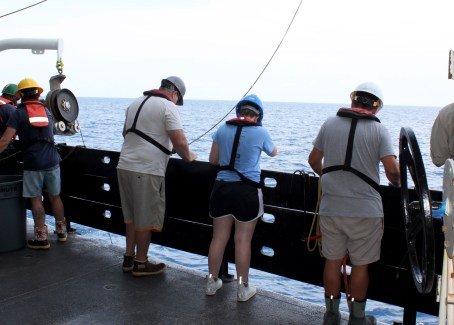NOAA Teacher at Sea
David Knight
Aboard NOAA Ship Pisces
July 10-23, 2018
Mission: Southeast Fishery-Independent Survey
Geographic Area: Southeastern U.S. coast
Date: July 17, 2018
Weather Data from the Bridge:
Latitude: 30° 30.2 N
Longitude: 80° 15.6 W
Sea wave height: 1-2 ft
Wind speed: 15 kts
Wind direction: 187°
Visibility: 10 nm
Air temperature: 30.1 °C
Barometric pressure: 1014.7 mB
Sky: Broken Clouds
Science and Technology Log
Warning!!! Great Science Ahead…
Part I.

As fish traps begin to be brought up by the deck crew, scientist wait to see what may be in the trap. I’ve actually found that I am looking over the deck in anticipation of new fish that may have been caught, or to see how many fish will need to be “worked up.” Once the fish have been removed from the trap and emptied into a large bin, they are then sorted by species into 17-gallon bins to determine the total weight of all fish. Moving 17 gallons worth of fish up to the lab bench to the scale can be quite a “work out.” There have been a couple of hauls that have captured so many fish of a particular species that more than one bin has to be used. After the fish have been weighed, the total length of each fish is determined to get a length frequency of the entire catch. For species like Tomtate (Haemulon aurolineatum), every fish is measured and then returned to the ocean. For some species, a pre-determined percentage are kept for a more detailed work up that may include the extraction of otoliths, removal of gonads, or a collection of stomach contents. The data collected from each fish will then be used by scientists in a number of different agencies and in different states to better understand the growth and reproduction of the particular species. All of this data is then used to create management plans for economically and ecologically important fish as well as to gain a better understanding of its life history.
Work Up
Length.

One may assume that a very long fish is also very old, but that is not necessarily the case. The length of a fish is not a good way to determine the age of a fish because factors such as temperature and food availability may alter the growth rate. Many fish grow very rapidly early on, but then slow their growth, so it is possible that a fish that is twelve years old is the same size as a fish that is three years old. Because many fish demonstrate logistic growth rates in terms of length, it is important to use additional pieces of data to determine their age.
Otolith.
In the head of ray-finned fish, one can find small, bone-like structures called otoliths. These structures have a variety of sensory functions that include detection of sound vibrations in water, movement, and its orientation in the water. As fish age, calcium carbonate will be added to the otolith, forming ring-like structures that can be used to determine the age of a fish, much like a tree will add new tissue each season forming tree rings. Otoliths are the best way to determine the actual age of a fish.


Be sure to check back for Part II. Gonads, Diet and DNA
Personal Log
The motion of the ship has not been a problem so far and I stopped taking any motion sickness pills after the first day. As I have been removing otoliths from fish, I cannot help but think about the similarities in how both fish and humans perceive their spatial environment and maintain balance. In our vestibular system, we too have otoliths that help to sense acceleration in a vertical and horizontal direction. Of course my thoughts then go to a dark place…what if someone were removing my otoliths to determine my age?
Did You Know?
The longest known life span in vertebrates is found in the Greenland Shark (Somniosus microcephalus). It is estimated that the Greenland shark grows less than 1 cm per year. Since sharks do not have otoliths, scientist have to analyze proteins found in the lens of their eye. In 2016, scientist from the University of Copenhagen collected a 5 m shark that was estimated to be about 392 years old, but may be anywhere from 272 to 512 years old.
Reference: Eye lens radiocarbon reveals centuries of longevity in the Greenland shark (Somniosus microcephalus). Science 12 Aug 2016: Vol. 353, Issue 6300, pp. 702-704

